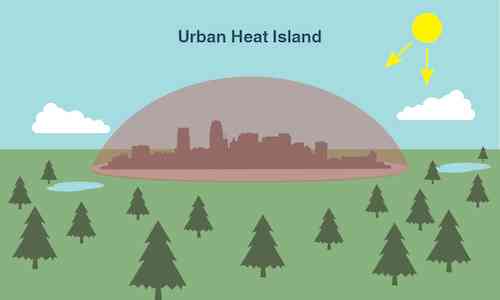
KNOWLEDGE of urban heat islands (UHI) is key for green building practices and smart cities and fundamental in delivering urban resilience hence, cities need more sustainable value chains, critical in the fight against climate impacts.
Urban infrastructure generates and stores large quantities of heat which require a cooling effect that has an impact on greenhouse gases.
The construction sector should carefully mainstream, consider space awareness and realisation in the outdoors through the provision of footpaths, cyclist lanes, pavements, trees, recreational centres, vegetation and water ponds in their urban infrastructure designs.
In short, urban infrastructure needs breathing spaces for enhanced circulation of air and extreme heat reduction. Although the "wall-streets" of the construction sector present picturesque views and layout, they are sources of unwanted urban heat stress, a major component of climate change.
Negative impacts of climate change have contributed to unbearably high temperatures, heatwaves, acid rain, flooding, strong winds, cyclones and hail and violent storms, among others. Urban areas, where buildings, roads and other infrastructure are highly concentrated, absorb and emit the sun’s heat more than natural landscapes, hence forests and water bodies are becoming "islands" of higher temperatures. This is called the urban heat island effect, where trees can help in many transformative ways. Trees and other forms of vegetation can absorb lots of heat reflection and stress that is common in cities thereby making everything cooler and comfortable.
The UHI effect is known to exacerbate heat, deteriorate air and water quality, including altering agricultural patterns and land-use practices, among others. The situation is normally worsened by air-conditioning machinery that ends up producing greenhouse gases if not properly maintained or when outdated. Issues of lighting are also very important in managing the urban heat island effect, depending on whether the material used in the construction absorbs too much heat or reflects it.
Urban constructors should make buildings more efficient in energy consumption, whether in cooling or heating systems. Efficiency is also required when choosing building materials and technologies so that urban infrastructure and buildings do not act as contributors to the greenhouse gas effect. This includes the way offices and homes have been designed over the years. Commercial and public buildings of this era are being sealed and artificially lit.
This is increasingly evident in the global environment posed by buildings which cannot be ignored.
- Desert Jewels outshine the Gems
- Gems ready for Malawi tourney
- Craftsmanship on verge of extinction
- On the African Vote at the UN the Blocking of Russia Today: The Lessons
Keep Reading
Demolishing old buildings and replacing them with new ones is key in managing energy efficiency. This also includes employing low or no carbon technologies to heat with most of the homes and buildings powered by solar cells, solar heaters, energy efficient bulbs, among others.
The concrete infrastructure in urban areas absorbs more heat because of the concentration of buildings, with concrete, asphalt, metal and other heat absorbing materials. Trees improve air quality through their leaves, which help to combat urban heat stress due to air pollution and other concentrations of gases. Occupants of these buildings normally suffer from respiratory system-related health issues, aggravated by extreme heat.
Preservation of trees also provides psychological benefits through stress and anxiety reduction. Urban green spaces offer mental relaxations, elevate mood and promote physical activities for a health well-being. The current construction standards should enable urban designs to mitigate urban heat effects and climate change. Due to the concentration and close contact of urban infrastructure, it warms up more than rural areas with spacious buildings.
It is important that the current urban set-up, with its concentrated buildings, should be able to adapt to the impacts of climate change, with fewer challenges. Cities and generated urban climate are causes of the urban heat island effect.
This is due to the climate of an urban area which influences ways in which city spaces should be utilised while climatic performance needs to adhere to the essential requirements and best practices of current infrastructural development. The urban set-up should play a role in influencing its own climate.
Urban buildings of the 21st century should fight the accumulation of urban heat, contribute to cooling systems and manage the urban heat island effect.
This is a result of the urban heat island literacy which is not much in the public domain hence it is architectural and built-environment commodified although urban heat island effect just like climate change has no boundaries. In the urban areas, there is also anthropogenic heat that is released by combustion processes such as traffic volumes and concentration, waste heating and industrial carbon emissions.
Because cities have a larger surface area compared to rural set-ups, large quantities of heat can be stored. In this regard, evaporation in urban areas can be reduced because of water-proof surfaces due to less vegetation and less permeable materials as compared to the rural areas.
Urban heat island is detrimental to human health through illnesses, heat-strokes and respiratory distress, among others. The act of covering roofs with vegetation has a cooling effect on the urban environment and the buildings. There is also the reduction of wind speed leading to effective cooling of buildings and concentrated urban infrastructure.
Building materials should also have a strong local relevance for climate change adaptation purposes as they are suitable for local conditions and are environmentally compliant. Locally sourced construction materials are cheaper but strong and resilient to climate change impacts.
Hard building materials accumulate heat while bricks store more heat and radiate it during the night. In this regard, it is internationally and locally significant that green building standards and urban heat island effect are firmly in the public domain for the sustainable development and circular economy that we all cherish.











